London buses on the streets, 1940s and 1950s
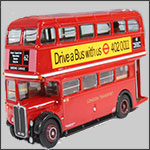
This page is about the experience of seeing London buses on the streets and travelling in them in the 1940s and 50s. It considers how they stood out from other traffic and their safety and comfort from the passenger's point of view.
____
By the webmaster, based childhood observations, discussions with people who lived with these buses and additional research
Double decker and single decker buses
An observer on the streets of the wider London area in the 1940s and 50s would never miss seeing a bus because its vivid red colour stood out. In fact, red buses were one of the icons of London. There were two types: those with an upstairs known as double deckers and those without known as single deckers. Double deckers were the norm.
The double decker buses were the norm, being more efficient in the number of passengers they could carry. The platform of the double decker buses led directly to the seats on the lower-deck and the stairs to the upper-deck.
Under the stairs was a space for luggage and a lockable compartment for the bus staff. On one side of the entrance was a black box for used tickets.
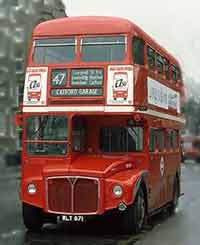
Double-decker bus. Detail from a photograph in London Bus Museum at Brooklands.
In my experience single deckers were only used on routes under low bridges or other such impediments.
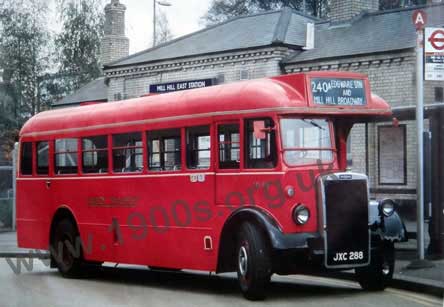
Single-decker bus. Detail from a photograph in London Bus Museum at Brooklands.
I went to school on a single decker because the route went under a low bridge. The one in the photo is the 240A which went from Edgware Station to my school in Mill Hill when the weather was too bad to cycle. The council provided me - and all school children - with a free bus pass if they I lived more than 3 miles from the school.
Safety and comfort on buses
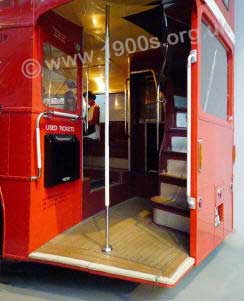
Double-decker bus entrance, showing the grab pole. Photographed
at the London Transport Museum. Note the slatted wood floor, just like in the
early 1900s buses.
(The no-entry sign placed by the museum has
been digitally removed.)
The buses had no doors, just an open platform with a vertical pole to hold onto while climbing aboard. This meant that passengers could get on and off buses while they were moving, which of course was recognised as unsafe. The trick for getting off a bus before it had quite stopped was to make sure that you were facing the direction of travel. Otherwise you would be knocked over backwards.
Buses were effectively open to the outside, letting in the cold and the fog - although they were an improvement from the buses with no roofs in my mother's childhood of the early 1900s.
In the very cold winters of 1947 and 1963, the condensation iced up the windows, and icicles grew from the ceilings. Some were 6-8 inches long and looked like the stalactites in caves. I remember them clearly. I don't know whether any of these icicles ever broke off, but if so it would have been perilous for anyone sitting underneath. As it was, tall passengers had to duck as they moved to a seat.
The rides were essentially comfortable until the early 1960s when the new Routemaster buses arrived. There was some trouble with the gear changing at certain speeds and the jolts for passengers was very significant indeed. Fortunately it didn't last long before smooth rides were recovered.
Adverts on buses
I saw a lot of buses when I was growing up because the Edgware bus terminus was so close to where I lived. My first recollection was of the buses like the one in the following photo with the 'eyes'. Every bus seemed to have them. They were actually advertising a magazine, but, as a young child, I didn't realise this and thought that the buses were given eyes, just as my dolls and teddy bears were given eyes. After all, buses needed to see where they were going. I was quite concerned when new adverts eventually replaced the eyes.
Another advert that deserves a place here, although I hardly noticed it at the time, was the 'Make do and Mend' one which aimed to encourage everyone to cope in the rationing and shortages of the Second World War and the years of austerity afterwards.
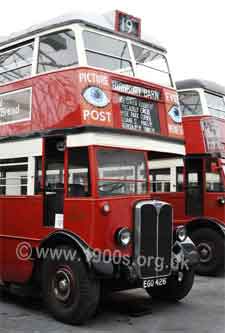
Bus showing the 'eyes' advert for Picture Post. Photo courtesy of Peter Hambrook.
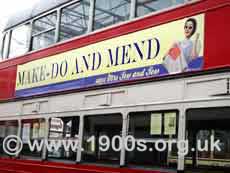
'Make do and mend' advert on the side of a bus. Photographed in London Bus Museum at Brooklands.
| sources | webmaster | contact |
Text and images are copyright
If you can add anything to this page or provide a photo, please contact me.



